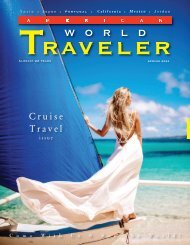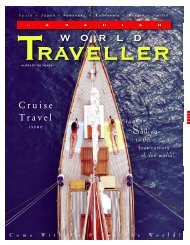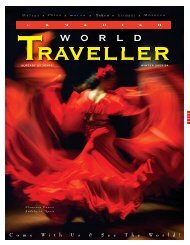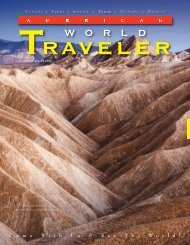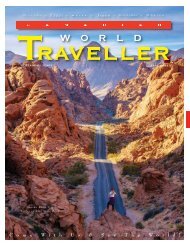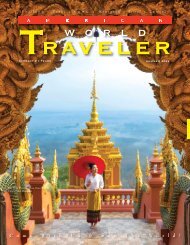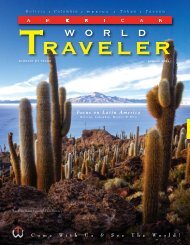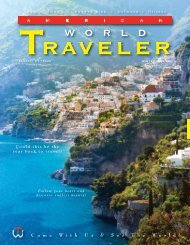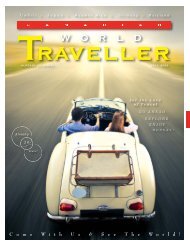American World Traveler Fall 2017 Issue
Now in our 15th year of publishing, American World Traveler explores the culture and history of worldwide destinations, sharing the adventure of discovery with our readers and motivating them to make their travel dreams a reality. Published quarterly, AWT helps sophisticated, independent American travelers choose their next destination by offering a lively blend of intelligent, informative articles and tantalizing photographic images from our World’s best destinations, cruises, accommodations and activities to suit every traveler's taste.
Now in our 15th year of publishing, American World Traveler explores the culture and history of worldwide destinations, sharing the adventure of discovery with our readers and motivating them to make their travel dreams a reality. Published quarterly, AWT helps sophisticated, independent American travelers choose their next destination by offering a lively blend of intelligent, informative articles and tantalizing photographic images from our World’s best destinations, cruises, accommodations and activities to suit every traveler's taste.
Create successful ePaper yourself
Turn your PDF publications into a flip-book with our unique Google optimized e-Paper software.
70<br />
Promenade, to watch the sun set and listen<br />
to the water!<br />
Inspired by the role that water played in the<br />
origin and growth of cities, Architect Nicola<br />
Bašić constructed the Sea Organ to re-connect<br />
people with the water. Waves push<br />
through a series of pipes and cavities under<br />
the marble steps and produce mystical<br />
sounds.<br />
In sharp contrast, the Promenade in Split is<br />
teeming with tourists, chatting in cafés,<br />
shopping for souvenirs or wandering with<br />
suitcases-on-wheels to and from the nearby<br />
ferry dock or bus station. The city’s main<br />
attraction, Diocletian’s Palace dating to 305<br />
CE, sees hundreds of tour groups traipsing<br />
after their guides.<br />
We discovered that the early morning was a<br />
cooler and quieter time to explore and take<br />
photos and when the groups started to<br />
arrive, we escaped to the town of Trogir.<br />
Here, smiling, friendly market vendors<br />
offered samples of home-made prosciutto<br />
and olive oil. In the UNESCO <strong>World</strong><br />
Heritage-designated old city, the stunning<br />
stone carvings on the Cathedral of St.<br />
Lawrence, as well as the scenery from the<br />
bell tower, were postcard perfect. And outside<br />
the city walls the ramparts of the 15th<br />
century Kamerlengo Fortress provided more<br />
great views of the city and the sea.<br />
The Island of Hvar is one of Croatia’s most<br />
popular destinations and after arriving by<br />
Ferry from Split, we climbed a flight of 79<br />
steep, stone steps, to our accommodation.<br />
However, just a short distance higher, was<br />
the Fortress Spanjola, where spectacular<br />
views are commonplace.<br />
Hvar is very picturesque walking town that<br />
appeals to both party goers as well as those<br />
looking to chill out. On the other side of the<br />
island there is a 45 minute walk from the<br />
tiny town of Jelsa, along the coast, to the<br />
equally tiny town of Vrboska. And along the<br />
way there is nothing but blue waters, rocky<br />
beaches, lush green trees and a few vacation<br />
homes.<br />
One hour away on the island of Korcula,<br />
the Cathedral of St. Mark as well as the<br />
Town Museum and the Bishop’s Treasury<br />
are definitely worth visiting. Just outside the<br />
city walls, the Marco Polo souvenir shops,<br />
the Marco Polo Museum and Marco Polo’s<br />
House, identify Korcula as the birthplace of<br />
the great explorer when it was part of the<br />
Venetian Empire.<br />
In the town of Lumbarda we walked<br />
through vineyards and tasted the locally<br />
produced wines: GRK (pronounced “gerk”)<br />
and Plavic (“plavich”). Bottles of each<br />
ended up in our take-home luggage.<br />
And finally after two weeks, we arrived in<br />
Dubrovnik and met Ivan for an introductory<br />
tour. The area outside the Pila Gate, which<br />
is the main entrance to the walled city, was<br />
packed with tourists, tour groups and diehard<br />
Game of Thrones fans. The city itself<br />
sees history oozing out of every building in<br />
every public square. With photographers<br />
brandishing selfie-sticks and crowding<br />
around St. Mary’s Cathedral, the Rectors<br />
Place, the Clock Tower, the fountains and<br />
more, it’s a very energetic place to explore.<br />
One of the highlights is the 90-minute walk<br />
on the city walls, where at dusk the sunlight<br />
shines magical colours on the buildings<br />
throughout the city.<br />
Our last night included an unbelievably<br />
tasty dinner at Konobo Bonaca in the town<br />
of Sustjepan: Seafood Salad, grilled squid<br />
and Scampi and a great bottle of local<br />
Merlot. Ivan Kapetanić the owner,<br />
explained that “Bonaca” (pronounced<br />
“Bonatsa”) described the calm, quiet state<br />
of the sea—perfect weather conditions for a<br />
fisherman. And it also seemed to describe<br />
so much of what we had seen and done in<br />
Croatia: the people we met, the conversations<br />
we had, the food, the attractions-- all<br />
had amounted to perfect conditions for<br />
travel.<br />
And when Ivan brought two glasses of<br />
Grappa ‘for service’, we toasted him and<br />
his family with “Živili”—“be filled with life”.<br />
It was a perfect ending to our holiday in<br />
Croatia and a very sincere way of saying<br />
“Thank you…we’ll be back”.<br />
www.visitcroatia.com<br />
<strong>American</strong> <strong>World</strong> <strong>Traveler</strong> <strong>Fall</strong> <strong>2017</strong>




